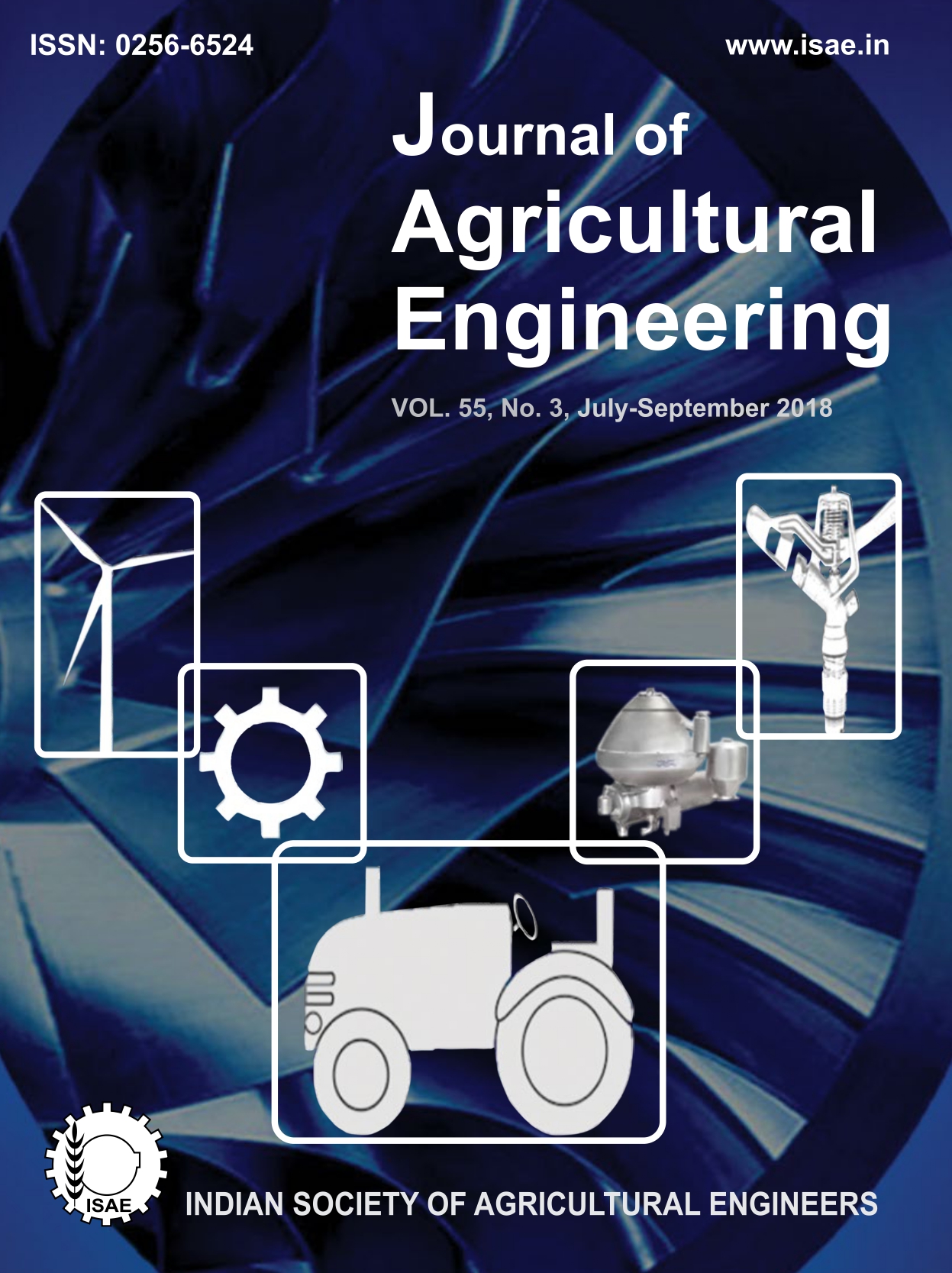Performance Evaluation of Tractor Operated Rotary Assisted Broad Bed Former-cum-seeder for Wheat Sowing
DOI:
https://doi.org/10.52151/jae2018553.1656Keywords:
Broad bed, simultaneous seeding, cost economics, energeticsAbstract
Tillage practices influence the soil physical parameters, which consequently affect the yield of a crop and provide solution against environmental hazards. A study was undertaken to comprehend the effects of broad bed former-cum-seeder on crop parameters, grain and biomass yield, cost-economics and energetics of operation. Simultaneous operation of tractor operated rotary-assisted broad bed former-cumseeder, developed at ICAR-Central Institute of Agricultural Engineering, was compared with sequential operation of conventional seed drill on broad beds and rotary tilling on flatbed in black cotton soil for wheat cultivation. Though higher germination of seeds (183 per m2 ) was observed with simultaneous operation of bed making and seeding by rotary-assisted broad bed former-cum-seeder, but the differences in yield among treatments were insignificant. The input energy requirement in first crop year (17,710 MJ.ha-1) was marginally higher than that in conventional method (17,445 MJ.ha-1). It decreased by 378 MJ.ha-1 compared to conventional system in the second crop year. The lowest average cost of operation (2607 ` ha-1) in simultaneous operation of bed forming and seeding in the first year, followed by maintaining permanent beds in subsequent years led to an additional income of 13,980 ` ha-1 over farmers’ practice. Rotary-assisted broad bed formercum-seeder thus has the potential to boost the income of the farmers and better energy management.
References
Anon. 2014. Minimum support price for rabi crops of 2014-15. Cabinet Committee on Economic Affairs (CCEA), Press Information Bureau, Government of India. Available from http://pib.nic.in/newsite/PrintRelease.aspx?relid=110936 (Accessed on 29-October-2014 20:05 IST)
Anon. 2015. DARE-ICAR Annual Report 2014-15. Department of Agricultural Research and Education, Ministry of Agriculture and Farmer Welfare, Govt. of India, 80-81.
Bhuyan M H M; Ferdousi M R; Iqbal M T; Hasan A K. 2016. Raised bed planting provides higher yield and less water inputs for transplanted boro rice (Oryza sativa) than conventional planting method. J. Adv. Stud. Agric. Biol. Envir. Sci., 3 (1), 17-31.
BIS. 1979. Guideline for Estimating Cost of Farm Machinery Operation. IS: 1964–1979, Bureau of Indian Standards, New Delhi, India.
Campbell C A; McConkey B G; Zentner R; Selles F; Curtin D. 1996. Long-term effects of tillage and crop rotations on soil organic C and total N in a clay soil in southwestern Saskatchewan. Can. J. Soil Sci., 76(3), 395-401.
Choudhury B U; Bouman B A M; Singh A K. 2007. Yield and water productivity of rice-wheat on raised beds at New Delhi, India. Field Crop Res., 100 (2-3), 229-239.
De D; Singh R; Chandra H. 2001. Technological impact on energy consumption in rainfed soybean cultivation in Madhya Pradesh. Appl. Energy, 70 (3), 193-213.
Dumanski J; Peiretti R. 2013. Modern concepts of soil conservation. Int. Soil Water Conser. Res., 1(1), 19-23.
Kleinfeld I H. 1992. Engineering Economics Analysis for Evaluation of Alternatives. John Wiley and Sons, USA, pp: 426.
Kumar Ashok; Sharma K D; Yadav Ashok. 2010. Enhancing yield and water productivity of wheat (Triticum aestivum) through furrow irrigated raised bed system in the Indo-Gangetic Plains of India. Indian J. Agric. Sci.., 80(3), 198-202.
Majeed A; Muhmood A; Niaz A; Javid S; Ahmad Z A; Shah S S H; Shah A H. 2015. Bed planting of wheat (Triticumaestivum L.) improves nitrogen use efficiency and grain yield compared to flat planting. Crop J., 3, 118-124.
Mandal K G; Saha K P; Hati K M; Singh V V; Mishra A K; Ghosh P K; Bandyopadhyay K K. 2005. Cropping systems of central India: An energy and economic analysis. J. Sust. Agric., 25(3), 117-140.
Mollah M I U; Bhuiya M S U; Hossain M S; Hossain S M A. 2015. Growth of wheat (Triticumaestivum L.) under raised bed planting method in rice-wheat cropping system. Bangladesh Rice J., 19(2), 47-56.
Pandey V P; Singh Bhagwan; Tripathy H P. 2012. Furrow irrigated raised bed (FIRB) system and advantages of raised bed planting in crop production. Financing Agric., 44 (2), 21-23.
Panesar B; Bhatnagar A. 1994. Energy Norms for Inputs and Outputs of Agricultural Sector, Energy Management and Conservation in Agricultural Production and Food Processing. USG Publishers and Distributors, Ludhiana, India, 5-16.
Rajput R P; Kauraw D L; Bhatnagar R K; Bhavsar Manish; Velayutham M; Lal R. 2009. Sustainable management of vertisols in central India. J. Crop Improv., 23(2), 119-135.
Shahin S; Jafari A; Mobli H; Rafiee S; Karimi M. 2008. Effect of farm size on energy ratio for wheat production: A case study from ardabil province of Iran. Am.Eurasian J. Agric. Environ. Sci., 3 (4), 604-608.
Sharma Peeyush; Abrol Vikas; Sharma R K. 2011. Impact of tillage and mulch management on economics, energy requirement and crop performance in maize– wheat rotation in rainfed sub-humid inceptisols, India. Eur. J. Agro., 34 (1), 46-51.
Singh H; Mishra D; Nahar N. 2002. Energy use pattern in production agriculture of a typical village in arid zone, India––part I. Energy Convers. Mgmt., 43(16), 2275-2286.
Singh J. 2002. On farm energy use pattern in different cropping systems in Haryana, India. Unpublished Master of Science Thesis, Int. Inst. Mgmt. Univ. Flensburg, Germany.
Singh S; Mittal J P. 1992. Energy in Production Agriculture. First edition, Mittal Publications, New Delhi, India., 103-105.
Singh Y. 2003. Crop residue management in rice-wheat system. In: RWCCIMMYT. Addressing Resource Conservation Issues in Rice-Wheat Systems of South Asia: A Resource Book. Rice-Wheat Consortium for the Indo-Gangetic Plains-CIMMYT, New Delhi, India, 153-158.
Singh Yadvinder; Humphreys E; Kukal S S; Singh B; Kaur Amanpreet; Thaman S; Prashar A; Yadav S; Timsina J; Dhillon S S; Kaur N; Smith D J; Gajri P R. 2009. Crop performance in permanent raised bed rice–wheat cropping system in Punjab, India. Field Crop Res., 110 (1), 1-20.
Syers J K; de Vries F P; Nyamudeza P. 2001. The Sustainable Management of Vertisols. Cabi Publishing, UK, pp: 307.














